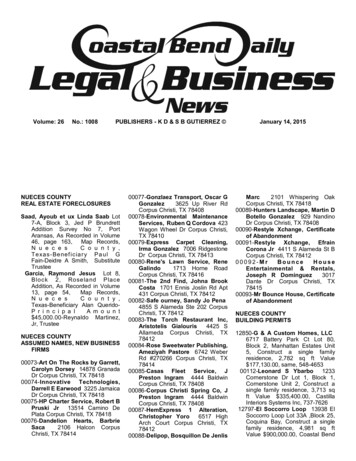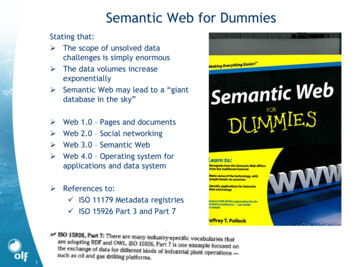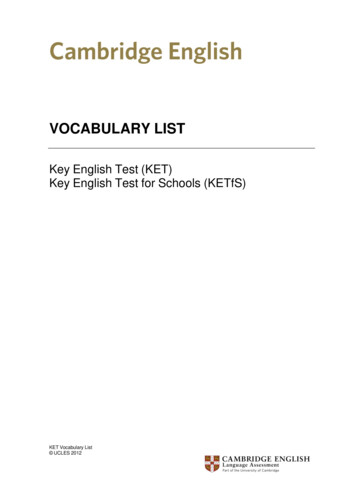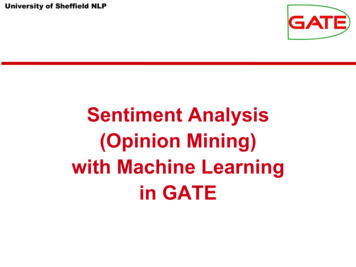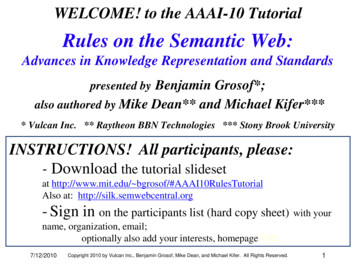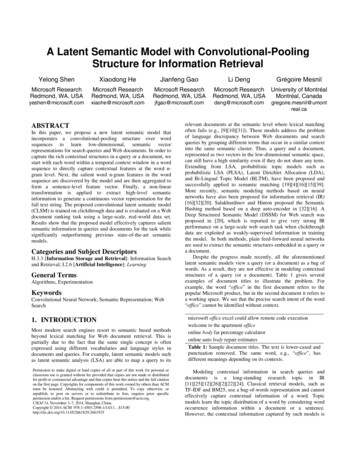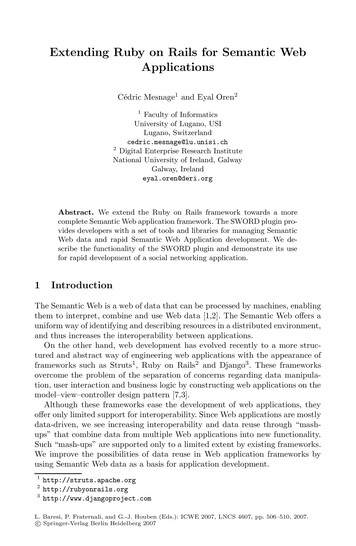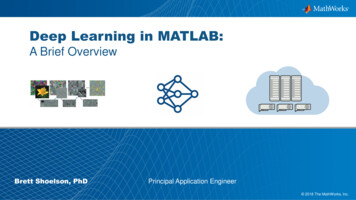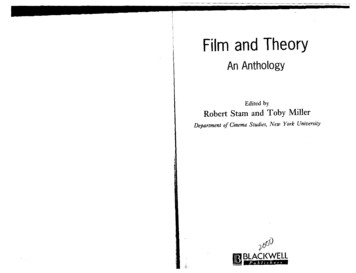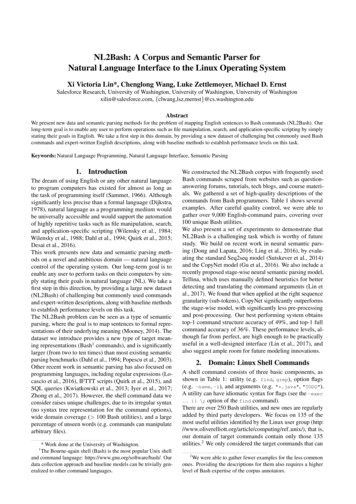
Transcription
NL2Bash: A Corpus and Semantic Parser forNatural Language Interface to the Linux Operating SystemXi Victoria Lin*, Chenglong Wang, Luke Zettlemoyer, Michael D. ErnstSalesforce Research, University of Washington, University of Washington, University of Washingtonxilin@salesforce.com, {clwang,lsz,mernst}@cs.washington.eduAbstractWe present new data and semantic parsing methods for the problem of mapping English sentences to Bash commands (NL2Bash). Ourlong-term goal is to enable any user to perform operations such as file manipulation, search, and application-specific scripting by simplystating their goals in English. We take a first step in this domain, by providing a new dataset of challenging but commonly used Bashcommands and expert-written English descriptions, along with baseline methods to establish performance levels on this task.Keywords: Natural Language Programming, Natural Language Interface, Semantic Parsing1.IntroductionThe dream of using English or any other natural languageto program computers has existed for almost as long asthe task of programming itself (Sammet, 1966). Althoughsignificantly less precise than a formal language (Dijkstra,1978), natural language as a programming medium wouldbe universally accessible and would support the automationof highly repetitive tasks such as file manipulation, search,and application-specific scripting (Wilensky et al., 1984;Wilensky et al., 1988; Dahl et al., 1994; Quirk et al., 2015;Desai et al., 2016).This work presents new data and semantic parsing methods on a novel and ambitious domain — natural languagecontrol of the operating system. Our long-term goal is toenable any user to perform tasks on their computers by simply stating their goals in natural language (NL). We take afirst step in this direction, by providing a large new dataset(NL2Bash) of challenging but commonly used commandsand expert-written descriptions, along with baseline methodsto establish performance levels on this task.The NL2Bash problem can be seen as a type of semanticparsing, where the goal is to map sentences to formal representations of their underlying meaning (Mooney, 2014). Thedataset we introduce provides a new type of target meaning representations (Bash1 commands), and is significantlylarger (from two to ten times) than most existing semanticparsing benchmarks (Dahl et al., 1994; Popescu et al., 2003).Other recent work in semantic parsing has also focused onprogramming languages, including regular expressions (Locascio et al., 2016), IFTTT scripts (Quirk et al., 2015), andSQL queries (Kwiatkowski et al., 2013; Iyer et al., 2017;Zhong et al., 2017). However, the shell command data weconsider raises unique challenges, due to its irregular syntax(no syntax tree representation for the command options),wide domain coverage ( 100 Bash utilities), and a largepercentage of unseen words (e.g. commands can manipulatearbitrary files).* Work done at the University of Washington.The Bourne-again shell (Bash) is the most popular Unix shelland command language: https://www.gnu.org/software/bash/. Ourdata collection approach and baseline models can be trivially generalized to other command languages.We constructed the NL2Bash corpus with frequently usedBash commands scraped from websites such as questionanswering forums, tutorials, tech blogs, and course materials. We gathered a set of high-quality descriptions of thecommands from Bash programmers. Table 1 shows severalexamples. After careful quality control, we were able togather over 9,000 English-command pairs, covering over100 unique Bash utilities.We also present a set of experiments to demonstrate thatNL2Bash is a challenging task which is worthy of futurestudy. We build on recent work in neural semantic parsing (Dong and Lapata, 2016; Ling et al., 2016), by evaluating the standard Seq2seq model (Sutskever et al., 2014)and the CopyNet model (Gu et al., 2016). We also include arecently proposed stage-wise neural semantic parsing model,Tellina, which uses manually defined heuristics for betterdetecting and translating the command arguments (Lin etal., 2017). We found that when applied at the right sequencegranularity (sub-tokens), CopyNet significantly outperformsthe stage-wise model, with significantly less pre-processingand post-processing. Our best performing system obtainstop-1 command structure accuracy of 49%, and top-1 fullcommand accuracy of 36%. These performance levels, although far from perfect, are high enough to be practicallyuseful in a well-designed interface (Lin et al., 2017), andalso suggest ample room for future modeling innovations.2.Domain: Linux Shell CommandsA shell command consists of three basic components, asshown in Table 1: utility (e.g. find, grep), option flags(e.g. -name, -i), and arguments (e.g. "*.java", "TODO").A utility can have idiomatic syntax for flags (see the -exec. . . {} \; option of the find command).There are over 250 Bash utilities, and new ones are regularlyadded by third party developers. We focus on 135 of themost useful utilities identified by the Linux user group f unix/), that is,our domain of target commands contain only those 135utilities.2 We only considered the target commands that can12We were able to gather fewer examples for the less commonones. Providing the descriptions for them also requires a higherlevel of Bash expertise of the corpus annotators.
Natural Languagefind .java files in the current directory tree that contain the pattern‘TODO’ and print their namesdisplay the 5 largest files in the current directory and its sub-directoriessearch for all jpg images on the system and archive them to tar ball “images.tar”Bash Command(s)grep -l "TODO" *.javafind . -name "*.java" -exec grep -il "TODO" {} \;find . -name "*.java" xargs -I {} grep -l "TODO" {}find . -type f sort -nk 5,5 tail -5du -a . sort -rh head -n5find . -type f -printf ’%s %p\n’ sort -rn head -n5tar -cvf images.tar (find / -type f -name *.jpg)tar -rvf images.tar (find / -type f -name *.jpg)find / -type f -name "*.jpg" -exec tar -cvf images.tar {} \;Table 1: Example natural language descriptions and the corresponding shell commands from NL2Bash.In-scopeOut-ofscope1. Single command2. Logical connectives: &&, , parentheses ()3. Nested commands:- pipeline - command substitution ()- process substitution ()1. I/O redirection , 2. Variable assignment 3. Compound statements:- if, for, while, util statements- functions4. Non-bash program strings nested withlanguage interpreters such as awk, sed,python, javaTable 2: In-scope and out-of scope syntax for the Bashcommands in our dataset.be specified in a single line (one-liners).3 Among them, weomitted commands that contain syntax structures such as I/Oredirection, variable assignment, and compound statementsbecause those commands need to be interpreted in context.Table 2 summarizes the in-scope and out-of-scope syntacticstructures of the shell commands we considered.3.Corpus ConstructionThe corpus consists of text–command pairs, where eachpair consists of a Bash command scraped from the weband an expert-generated natural language description. Ourdataset is publicly available for use by other /tree/master/data.We collected 12,609 text–command pairs in total (§3.1.).After filtering, 9,305 pairs remained (§3.2.). We split thisdata into train, development (dev), and test sets, subject tothe constraint that neither a natural language description nora Bash command appears in more than one split (§3.4.).3.1.Data CollectionWe hired 10 Upwork4 freelancers who are familiar withshell scripting. They collected text–command pairs fromweb pages such as question-answering forums, tutorials,tech blogs, and course materials. We provided them a webinferface to assist with searching, page browsing, and dataentry.The freelancers copied the Bash command from the webpage, and either copied the text from the webpage or wrotethe text based on their background knowledge and the webpage context. We restricted the natural language descriptionto be a single sentence and the Bash command to be a oneliner. We found that oftentimes one sentence is enough toaccurately describe the function of the command.5The freelancers provided one natural-language descriptionfor each command on a webpage. A freelancer might annotate the same command multiple times in different webpages,and multiple freelancers might annotate the same command(on the same or different webpages). Collecting multipledifferent descriptions increases language diversity in thedataset. On average, each freelancer collected 50 pairs/hour.3.2.Data CleaningWe used an automated process to filter and clean the dataset,as described below. Our released corpus includes the filtereddata, the full data, and the cleaning scripts.Filtering The cleaning scripts removed the following commands. Non-grammatical commands that violate the syntaxspecification in the Linux man pages (https://linux.die.net/man/). Commands that contain out-of-scope syntactic structures shown in Table 2. Commands that are mostly used in multi-statementshell scripts (e.g. alias and set). Commands that contain non-bash language interpreters(e.g. python, c , brew, emacs). These commandscontain strings in other programming languages.Cleaning We corrected spelling errors in the natural language descriptions using a probabilistic spell checker (http://norvig.com/spell-correct.html). We also manually corrected a subset of the spelling errors that bypassed the spellchecker in both the natural language and the shell commands.For Bash commands, we removed sudo and the shell input3We decided to investigate this simpler case prior to synthesizing longer shell scripts because one-liner Bash commands arepractically useful and have simpler structure. Our baseline resultsand analysis (§6.) show that even this task is challenging.4http://www.upwork.com/5As discussed in §6.3., in 4 out of 100 examples, a one-sentencedescription is difficult to interpret. Future work should investigateinteractive natural language programming approaches in thesescenarios.
# sent.# word8,5597,790# words per sent.avg.median11.711# sent. per wordavg.median14.01Table 3: Natural Language Statistics: # unique sentences, #unique words, # words per sentence and # sentences that a wordappears in.# tokens / cmd # cmds / tokenavg. median avg. median6,234 7.7711.51# cmd # temp # token7,5874,602# reserv. # cmds / util. # cmds / flag# utility # flagtokenavg. median avg. median10220615155.038101.7 7.5Table 4: Bash Command Statistics. The top table contains #avg.1.09# cmd per nlmedian max19avg.1.23# nl per cmdmedian max122Table 5: Natural Language to Bash Mapping Statistics2002), but rare for traditional semantic parsing ones (Dahlet al., 1994; Zettlemoyer and Collins, 2005).As discussed in §4. and §6.2., the many-to-many mappingaffects both evaluation and modeling choices.Utility Distribution Figure 1 shows the top 50 most common Bash utilities in our dataset and their frequencies inlog-scale. The distribution is long-tailed: the top most frequent utility find appeared 6,268 times and the second mostfrequent utility xargs appeared 1,047 times. The 52 leastcommon bash utilities, in total, appeared only 984 times.7unique commands, # unique command templates, # unique tokens,# tokens per command and # commands that a token appears in.The bottom table contains # unique utilities, # unique flags, #unique reserved tokens, # commands a utility appears in and #commands a flag appears in.prompt characters such as “ ” and “#” from the beginningof each command. We replaced the absolute pathnames forutilities by their base names (e.g., we changed /bin/findto find).3.3.Corpus StatisticsAfter filtering and cleaning, our dataset contains 9,305 pairs.The Bash commands cover 102 unique utilities using 206flags — a rich functional domain.Monolingual Statistics Tables 3 and 4 show the statisticsof natural language (NL) and Bash commands in our corpus.The average length of the NL sentences and Bash commandsare relatively short, being 11.7 words and 7.7 tokens respectively. The median word frequency and command tokenfrequency are both 1, which is caused by the large numberof open-vocabulary constants (file names, date/time expressions, etc.) that appeared only once in the corpus.6We define a command template as a command with itsarguments replaced by their semantic types. For example, the template of grep -l "TODO" *.java is grep -l[regex] [file].Mapping Statistics Table 5 shows the statistics of naturallanguage to Bash command mappings in our dataset. Whilemost of the NL sentences and Bash commands form oneto-one mappings, the problem is naturally a many-to-manymapping problem — there exist many semantically equivalent commands, and one Bash command may be phrasedin different NL descriptions. This many-to-many mappingis common in machine translation datasets (Papineni et al.,6As shown in figure 1, the most frequent bash utilities appearedover 6,000 times in the corpus. Similarly, natural language wordssuch as “files”, “in” appeared in 5,871 and 5,430 sentences, respectively. These extremely high frequency tokens are the reasonfor the significant difference between the averages and medians inTables 3 and 4.Figure 1: Top 50 most frequent bash utilities in the datasetwith their frequencies in log scale. U1 and U2 at the bottomof the circle denote the utilities basename and readlink.The appendix (§10.) gives more corpus statistics.3.4.Data SplitWe split the filtered data into train, dev, and test sets (Table 6). We first clustered the pairs by NL descriptions — acluster contains all pairs with the identical normalized NLdescription. We normalized an NL description by lowercasing, stemming, and stop-word filtering, as describedin §6.1.We randomly split the clusters into train, dev, and test at aratio of 10:1:1. After splitting, we moved all developmentand test pairs whose command appeared in the train setinto the train set. This prevents a model from obtaininghigh accuracy by trivially memorizing a natural language7The utility find is disproportionately common in our corpus.This is because we collected the data in two separated stages. Asa proof of concept, we initially collected 5,413 commands thatcontain the utility find (and may also contain other utilities). Afterthat, we allow the freelancers to collect all commands that containany of the 135 utilities described in §2.
description or a command it has seen in the train set, whichallows us to evaluate the model’s ability to generalize.# pairs# unique nlsTrain8,0907,340Dev609549Test606547Table 6: Data Split Statistics4.Evaluation MethodologyIn our dataset, one natural language description may havemultiple correct Bash command translations. This presentschallenges for evaluation since not all correct commands arepresent in our dataset.Manual Evaluation We hired three Upwork freelancerswho are familiar with shell scripting. To evaluate a particularsystem, the freelancers independently evaluated the correctness of its top-3 translations for all test examples. For eachcommand translation, we use the majority vote of the threefreelancers as the final evaluation.We grouped the test pairs that have the same normalized NLdescriptions as a single test instance (Table 6). We report twotypes of accuracy: top-k full command accuracy (AcckF ) andtop-k command template accuracy (AcckT ). We define AcckFto be the percentage of test instances for which a correctfull command is ranked k or above in the model output. Wedefine AcckT to be the percentage of test instances for whicha correct command template is ranked k or above in themodel output (i.e., ignoring incorrect arguments).Table 7 shows the inter-annotator agreement between thethree pairs of our freelancers on both the template judgement(αT ) and full-command judgement (αF ).Pair 1αFαT0.89 0.81Pair 2αFαT0.83 0.82Pair 3αFαT0.90 0.89Table 7: Inter-annotator agreement.Previous approaches Previous NL-to-code translationwork also noticed similar problems.(Kushman and Barzilay, 2013; Locascio et al., 2016) formally verify the equivalence of different regular expressionsby converting them to minimal deterministic finite automaton (DFAs).Others (Kwiatkowski et al., 2013; Long et al., 2016; Guuet al., 2017; Iyer et al., 2017; Zhong et al., 2017) evaluatethe generated code through execution. As Bash is a Turingcomplete language, verifying the equivalence of two Bashcommands is undecidable. Alternatively, one can checkcommand equivalence using test examples: two commandscan be executed in a virtual environment and their execution outcome can be compared. We leave this evaluationapproach to future work.Some other works (Oda et al., 2015) have adopted fuzzy evaluation metrics, such as BLEU, which is widely used to measure the translation quality between natural languages (Doddington, 2002). Appendix C shows that the n-gram overlapcaptured by BLEU is not effective in measuring the semanticsimilarity for formal languages.5.System Design ChallengesThis section lists challenges for semantic parsing in the Bashdomain.Rich Domain The application domain of Bash rangesfrom file system management, text processing, network control to advanced operating system functionality such as process management. Semantic parsing in Bash is equivalent tosemantic parsing for each of the applications. In comparison,many previous works focus on only one domain (§7.).Out-of-Vocabulary Constants Bash commands containmany open-vocabulary constants such as file/path names,file properties, time expressions, etc. These form the unseentokens for the trained model. Nevertheless, a semantic parseron this domain should be able to generate those constants inits output. This problem exists in nearly all NL-to-code translation problems but is particularly severe for Bash (§3.3.).What makes the problem worse is that oftentimes, the constants corresponding to the command arguments need to beproperly reformatted following idiomatic syntax rules.Language Flexibility Many bash commands have a largeset of option flags, and multiple commands can be combinedto solve more complex tasks. This often results in multiplecorrect solutions for one task (§3.3.), and poses challengesfor both training and evaluation.Idiomatic Syntax The Bash interpreter uses a shallowsyntactic grammar to parse pipelines, code blocks, and otherhigh-level syntax structures. It parses command options using pattern matching and each command can have idiomaticsyntax rules (e.g. to specify an ssh remote, the formatneeds to be [USER@]HOST:SRC). Syntax-tree-based parsingapproaches (Yin and Neubig, 2017; Guu et al., 2017) arehence difficult to apply.6.Baseline System PerformanceTo establish performance levels for future work, we evaluated two neural machine translation models that have demonstrated strong performance in both NL-to-NL translation andNL-to-code translation tasks, namely, Seq2Seq (Sutskeveret al., 2014; Dong and Lapata, 2016) and CopyNet (Gu etal., 2016). We also evaluated a stage-wise natural languageprograming model, Tellina (Lin et al., 2017), which includesmanually-designed heuristics for argument translation.Seq2Seq The Seq2Seq (sequence-to-sequence) model defines the conditional probability of an output sequence giventhe input sequence using an RNN (recurrent neural network)encoder-decoder (Jain and Medsker, 1999; Sutskever et al.,2014). When applied to the NL-to-code translation problem, the input natural language and output commands aretreated as sequences of tokens. At test time, the commandsequences with the highest conditional probabilities wereoutput as candidate translations.CopyNet CopyNet (Gu et al., 2016) is an extension ofSeq2Seq which is able to select sub-sequences of the inputsequence and emit them at proper places while generatingthe output sequence. The copy action is mixed with theregular token generation of the Seq2Seq decoder and thewhole model is still trained end-to-end.
Tellina The stage-wise natural language programingmodel, Tellina (Lin et al., 2017), first abstracts the constants in an NL to their corresponding semantic types (e.g.File and Size) and performs template-level NL-to-codetranslation. It then fills the argument slots in the code template with the extracted constants using a learned alignmentmodel and reformatting heuristics.6.1.Implementation DetailsWe used the Seq2Seq formulation as specified in (Sutskeveret al., 2014). We used the gated recurrent unit (GRU) (Chunget al., 2014) RNN cells and a bidirectional RNN (Schusterand Paliwal, 1997) encoder. We used the copying mechanism proposed by (Gu et al., 2016). The rest of the modelarchitecture is the same as the Seq2Seq model.We evaluated both Seq2Seq and CopyNet at three levels oftoken granularities: token, character and sub-token.Pre-processing We used a simple regular-expressionbased natural language tokenizer and the Snowball stemmer to tokenize and stem the natural language. We converted all closed-vocabulary words in the natural languageto lowercase and removed words in a stop-word list. Weremoved all NL tokens that appeared less than four timesfrom the vocabulary for the token- and sub-token-basedmodels. We used a Bash parser augmented from Bashlex(https://github.com/idank/bashlex) to parse and tokenize thebash commands.To compute the sub-tokens8 , we split every constant in boththe natural language and Bash commands into consecutivesequences of alphabetical letters and digits; all other characters are treated as an individual sub-token. (All Bashutilities and flags are treated as atomic tokens as they arenot constants.) A sequence of sub-tokens as the result of atoken split is padded with the special symbols SUB STARTand SUB END at the beginning and the end. For example, thefile path “/home/dir03/*.txt” is converted to the sub-tokensequence: SUB START, “/”, “home”, “/”, “dir”, “03”, “/”, “*”,“.”, “txt”, SUB END.Hyperparameters The dimension of our decoder RNN is400. The dimension of the two RNNs in the bi-directionalencoder is 200. We optimized the learning objective withmini-batched Adam (Kingma and Ba, 2014), using the default momentum hyperparameters. Our initial learning rateis 0.0001 and the mini-batch size is 128. We used variational RNN dropout (Gal and Ghahramani, 2016) with 0.4dropout rate. For decoding we set the beam size to 100. Thehyperparameters were set based on the model’s performanceon a development dataset (§3.4.).Our baseline system implementation is released on Github:https://github.com/TellinaTool/nl2bash.8As discussed in §6.2., the simple sub-token based approachis surprisingly effective for this problem. It avoids modeling verylong sequences, as the character-based models do, by preservingtrivial compositionality in consecutive alphabetical letters and digits. On the other hand, the separation between letters, digits, andspecial tokens explicitly represented most of the idiomatic syntaxof Bash we observed in the data: the sub-token based models effectively learn basic string manipulations (addition, deletion andreplacement of substrings) and the semantics of Bash reservedtokens such as , ", *, ble 8: Translation accuracies of the baseline systems on100 instances sampled from the dev set.6.2.ResultsTable 8 shows the performance of the baseline systems on100 examples sampled from our dev set. Since manuallyevaluating all 7 baselines on the complete dev set is expensive, we report the manual evaluation results on a sampledsubset in Table 8 and the automatic evaluation results on thefull dev set in Appendix C.Table 11 shows a few dev set examples and the baselinesystem translations. We now summarize the comparisonbetween the different systems.Token Granularity In general, token-level modelingyields higher command structure accuracy compared to using characters and sub-tokens. Modeling at the other twogranularities gives higher full command accuracy. This isexpected since the character and sub-token models needto learn token-level compositions. They also operate overlonger sequences which presents challenges for the neuralnetworks. It is somewhat surprising that Seq2Seq at thecharacter level achieves competitive full command accuracy. However, the structure accuracy of these models issignificantly lower than the other two counterparts.9Copying Adding copying slightly improves the characterlevel models. This is expected as out-of-vocabulary characters are rare. Using token-level copying improves full command accuracy significantly from vanilla Seq2Seq. However,the command template accuracy drops slightly, possibly dueto the mismatch between the source constants and the command arguments, as a result of argument reformatting. Weobserve a similarly significant full command accuracy improvement by adding copying at the sub-token level. Theresulting ST-CopyNet model has the highest full commandaccuracy and competitive command template accuracy.End-To-End vs. Pipline The Tellina model which doestemplate-level translation and argument filling/reformattingin a stage-wise manner yields the second-best full commandaccuracy and second-best structure accuracy. Nevertheless,the higher full command accuracy of ST-CopyNet (especially on the Acc3T metrics) shows that learned string-leveltransformations out-perform manually written heuristics9(Lin et al., 2017) reported that incorrect commands can helphuman subjects, even when their arguments contain errors. Thisis because in many cases the human subjects were able to changeor replace the wrong arguments based on their prior knowledge.Given this finding, we expect pure character-based models to beless useful in practice compared to the other two groups if wecannot find ways to improve their command structure accuracy.
c1T0.490.53Acc3T0.610.62Table 9: Translation accuracies of ST-CopyNet and Tellinaon the full test set.Figure 3: Number of error instances in each error classesof ST-CopyNet and Tellina. The classes marked with s areunique to the pipeline system.Figure 2: Error overlap of ST-CopyNet and Tellina. Thenumber denotes the percentage out of the 100 dev samples.when enough data is provided. This shows the promiseof applying end-to-end learning on such problems in futurework.Table 9 shows the test set accuracies of the top-two performing approaches, ST-CopyNet and Tellina, evaluated on theentire test set. The accuracies of both models are higherthan those on the dev set10 , but the relative performancegap holds: ST-CopyNet performs significantly better thanTellina on the full command accuracy, with only a milddecrease in structure accuracy.Section 6.3. furthur discusses the comparison between thesetwo systems through error analysis.6.3.Error AnalysisWe manually examined the top-1 system outputs of STCopyNet and Tellina on the 100 dev set examples and compared their error cases.Figure 2 shows the error case overlap of the two systems.For a significant proportion of the examples both systemsmade mistakes in their translation (44% by command structure error and 59% by full command error). This is becausethe base model of the two systems are similar — they areboth RNN based models that perform sequential translation. Many such errors were caused by the NL describing afunction that rarely appeared in the train set, or the GRUsfailing to capture certain portions of the NL descriptions.For cases where only one of the models makes mistakes,Tellina makes fewer template errors and ST-CopyNet makesfewer full command errors.We categorized the error causes of each system (Figure 3),and discuss the major error classes below.Sparsity in Training Data For both models, the top-oneerror cause is when the NL description maps to utilities orflags that rarely appeared in the train set (Table 10). Asmentioned in section 2., the bash domain consists of a largenumber of utilities and flags and it is expensive to gatherenough training data for all of them.10One possible reason is that two different sets of programmersevaluated the results on dev and test.Sparsity in training datafind all the text files in the file system and searchonly in the disk partition of the root.Constant enumerationAnswer “n” to any prompts in the interactiverecursive removal of “dir1”, “dir2”, and “dir3”.Complex taskRecursively finds all files in a current folderexcluding already compressed files and compressesthem with level 9.Intelligible/Non-grammatical descriptionFind all regular files in the current directory treeand print a command to move them to the currentdirectory.Table 10: Samples of natural language descriptions for themajor error causes.Common Errors of RNN Translation Models The second major error class is commonly-known errors for RNNbased translation models (utility error, flag error and argument formatting error in Figure 3). When the RNN misinterprets or overlooks certain chunks of NL descriptions,the decoder can generate a wrong utility/flag or omit a utility/flag from the output sequence. Since the ST-CopyNetmodel also relies on the RNNs to generate sub-token contents, it suffers more from such problems — the sub-tokenbased models in general have more command structure errors and they frequently generated arguments that are a fewedit distance away from the correct ones. Interestingly, wenoticed that few command template errors are syntax errors.The output commands often remain executable despite thesemantic errors in different Bash components.Constant Enumeration In some cases, the NL descriptions contain sequences of constant values as an enumerationof system objects or string patterns (Table 10). We observedthat both models str
Keywords:Natural Language Programming, Natural Language Interface, Semantic Parsing 1. Introduction The dream of using English or any other natural language to program computers has existed for almost as long as the task of programming itself (Sammet, 1966). Although si

